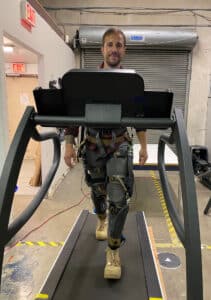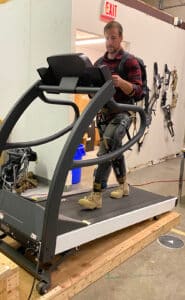
The Amplify combines elements of Bionic Power’s energy harvesting exoskeleton with those of a powered knee exoskeleton (not all that dissimilar from a hybrid car using regenerative breaks). It straps around your lower leg and thigh and attaches to a hip belt, preventing the device from sliding down the leg with gravity or rotating too much around the leg. “It was not very difficult at all to put it on and take it off,” reflects Matt. “I could probably put it on in less than a minute and take it off in less than 30 seconds with a little practice.”
Paraphrasing Matt’s initial impressions: “The Amplify exoskeleton was quite powerful. It resembles other active lower body exoskeletons for walking, like the Lockheed Martin ONYX and the Keeogo by B-Temia. It was strong but adjustable for how much torque it could provide, how quickly the torque could ramp up or down, and the range of motion. For a quick and dirty test, while walking on a treadmill with the Amplify device, I pulled out my phone to see my heart rate from my Whoop 4.0. I walked with the exoskeleton turned on for a few minutes, letting my heart rate settle in for that intensity. Then I turned the exoskeleton off, repeating this process about half a dozen times. When the Amplify device was turned off, my heart rate went up, and my heart rate went down when it was turned on. On an inclined treadmill, the activity got easier when I turned the exoskeleton on, and when I turned the exoskeleton off, I had to work harder. There was a clear, for me at least, metabolic benefit. Of course, a soldier has to carry much more than 30-40 lbs, but this experience gave me enough of a sense to understand the potential for how helpful this type of device can be.”
Matt also had the opportunity to try out the Amplify outside: “We walked up and down the street, found a small but steep hill to move around on, and climbed up and down stairs several times, and the assistance was very obvious. It was good at helping me climb up and down the hills and stairs, it didn’t interfere with my ability to balance and move on uneven terrain, and when I turned the exoskeleton off, I could feel the difference. I could feel how much assistance it provided with each step. There is no better way to understand an exoskeleton like the Amplify device than to put it on and feel what it can do.”
Opportunities for Improvement:
Comfort and control are two major areas where the Amplify exoskeleton can be improved. “I wanted to have some capability to adjust it, or have the machine adjust itself,” elaborates Matt. “For example, when I was on level ground, it felt like too much assistance, and I wanted to turn it down a little because it would have been more comfortable. It would also be nice to improve the control based on the type of activity. If the Amplify has to be comfortable enough to be worn by soldiers on long missions that can span days, it needs to know when to ramp up and ramp down the level of assistance it provides and when to become “invisible” to its users. In the civilian market, the Amplify must be comfortable while doing heavy physical work, for example, utility or forestry work in remote locations, otherwise people will not use it. So comfort and control will be essential to gain acceptance from users, and the Bionic Power team knows that.”

It is not likely that energy demands on dismounted soldiers will go down anytime soon. It is more likely to increase. If the machine can meet (or complement) the energy needs of soldiers, it may be able to serve a purpose and have a potential adoption pathway in the defense industry.
“The team at Bionic Power were a pleasure to work with, super kind, friendly, and great hosts,” concludes Matt. “I appreciated them letting me try out all of their exoskeletons, and I understand that these are only prototypes, not the final products. I’m looking forward to seeing where they can go from here.”
This article does not endorse Bionic Power or any company products. This work is purely informative. It captures the visit of an exoskeleton and ergonomics expert to Bionic Power’s HQ and his observations and impressions as retold later.

This article was completed with the insights and contributions of Matthew Marino, PT, MSPT, CPE, CSCS, TSAC-F, a founding Partner of the ASTM Exo Technology Center of Excellence, and co-owner of Prime Performance LLC. Matt has over 20 years of experience in rehabilitation, health and fitness, ergonomics, and the design, testing, use, and implementation of wearable sensor and exoskeleton technologies (LinkedIn)









Thanks again for visiting Matt. We really appreciate your honest feedback, as it it users who define what our projects become – the user’s needs are paramount! Hopefully you can visit again when we have an adjustable version of our medical Agilik device to try (it is purely custom now, making use of a fully customized KAFO).
Thanks for the article Bobby. Hopefully we get to show you our products as well!
Thank you Rob!
Hey my name is John. I have been in two bad car accidents. The first I compound fractured myleft tibia/fibia and have a metal rod and right Femara. Some years later I was in another accident that crushed my pelvis. They removed the rod in my right Femara but now my right side hurts like my left use to. I walk a lot and starting to slowly jog. Could this product help with my pain and speed?
Hi John, there have been major innovations and changes to the Agilik – Bionic Power device. Please visit the producer’s website for the latest at: https://bionic-power.com I think it would be best if you reach out to them directly. From my point of view, their exoskeleton could likely be helpful to you!
Thanks for reaching out John, and for the response Bobby! Yes, please email us directly at info(at)bionic-power.com and our product specialist can get more details about your condition and your location. Cheers!